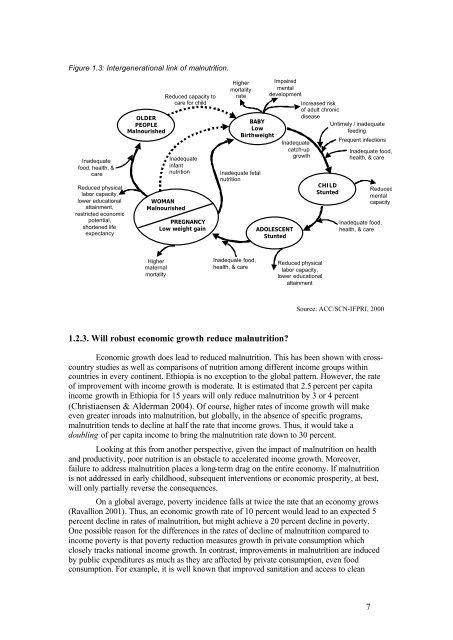An assessment of the causes of malnutrition in Ethiopia: A ...
An assessment of the causes of malnutrition in Ethiopia: A ...
An assessment of the causes of malnutrition in Ethiopia: A ...
You also want an ePaper? Increase the reach of your titles
YUMPU automatically turns print PDFs into web optimized ePapers that Google loves.
Figure 1.3: Intergenerational l<strong>in</strong>k <strong>of</strong> <strong>malnutrition</strong>.<br />
Inadequate<br />
food, health, &<br />
care<br />
Reduced physical<br />
labor capacity,<br />
lower educational<br />
atta<strong>in</strong>ment,<br />
restricted economic<br />
potential,<br />
shortened life<br />
expectancy<br />
OLDER<br />
PEOPLE<br />
Malnourished<br />
Reduced capacity to<br />
care for child<br />
Inadequate<br />
<strong>in</strong>fant<br />
nutrition<br />
WOMAN<br />
Malnourished<br />
PREGNANCY<br />
Low weight ga<strong>in</strong><br />
Higher<br />
mortality<br />
rate<br />
BABY<br />
Low<br />
Birthweight<br />
Inadequate fetal<br />
nutrition<br />
Impaired<br />
mental<br />
development<br />
ADOLESCENT<br />
Stunted<br />
Inadequate<br />
catch-up<br />
growth<br />
Increased risk<br />
<strong>of</strong> adult chronic<br />
disease<br />
Untimely / <strong>in</strong>adequate<br />
feed<strong>in</strong>g<br />
CHILD<br />
Stunted<br />
Frequent <strong>in</strong>fections<br />
Inadequate food,<br />
health, & care<br />
Reduced<br />
mental<br />
capacity<br />
Inadequate food,<br />
health, & care<br />
Higher<br />
maternal<br />
mortality<br />
Inadequate food,<br />
health, & care<br />
Reduced physical<br />
labor capacity,<br />
lower educational<br />
atta<strong>in</strong>ment<br />
Source: ACC/SCN-IFPRI, 2000<br />
1.2.3. Will robust economic growth reduce <strong>malnutrition</strong>?<br />
Economic growth does lead to reduced <strong>malnutrition</strong>. This has been shown with crosscountry<br />
studies as well as comparisons <strong>of</strong> nutrition among different <strong>in</strong>come groups with<strong>in</strong><br />
countries <strong>in</strong> every cont<strong>in</strong>ent. <strong>Ethiopia</strong> is no exception to <strong>the</strong> global pattern. However, <strong>the</strong> rate<br />
<strong>of</strong> improvement with <strong>in</strong>come growth is moderate. It is estimated that 2.5 percent per capita<br />
<strong>in</strong>come growth <strong>in</strong> <strong>Ethiopia</strong> for 15 years will only reduce <strong>malnutrition</strong> by 3 or 4 percent<br />
(Christiaensen & Alderman 2004). Of course, higher rates <strong>of</strong> <strong>in</strong>come growth will make<br />
even greater <strong>in</strong>roads <strong>in</strong>to <strong>malnutrition</strong>, but globally, <strong>in</strong> <strong>the</strong> absence <strong>of</strong> specific programs,<br />
<strong>malnutrition</strong> tends to decl<strong>in</strong>e at half <strong>the</strong> rate that <strong>in</strong>come grows. Thus, it would take a<br />
doubl<strong>in</strong>g <strong>of</strong> per capita <strong>in</strong>come to br<strong>in</strong>g <strong>the</strong> <strong>malnutrition</strong> rate down to 30 percent.<br />
Look<strong>in</strong>g at this from ano<strong>the</strong>r perspective, given <strong>the</strong> impact <strong>of</strong> <strong>malnutrition</strong> on health<br />
and productivity, poor nutrition is an obstacle to accelerated <strong>in</strong>come growth. Moreover,<br />
failure to address <strong>malnutrition</strong> places a long-term drag on <strong>the</strong> entire economy. If <strong>malnutrition</strong><br />
is not addressed <strong>in</strong> early childhood, subsequent <strong>in</strong>terventions or economic prosperity, at best,<br />
will only partially reverse <strong>the</strong> consequences.<br />
On a global average, poverty <strong>in</strong>cidence falls at twice <strong>the</strong> rate that an economy grows<br />
(Ravallion 2001). Thus, an economic growth rate <strong>of</strong> 10 percent would lead to an expected 5<br />
percent decl<strong>in</strong>e <strong>in</strong> rates <strong>of</strong> <strong>malnutrition</strong>, but might achieve a 20 percent decl<strong>in</strong>e <strong>in</strong> poverty.<br />
One possible reason for <strong>the</strong> differences <strong>in</strong> <strong>the</strong> rates <strong>of</strong> decl<strong>in</strong>e <strong>of</strong> <strong>malnutrition</strong> compared to<br />
<strong>in</strong>come poverty is that poverty reduction measures growth <strong>in</strong> private consumption which<br />
closely tracks national <strong>in</strong>come growth. In contrast, improvements <strong>in</strong> <strong>malnutrition</strong> are <strong>in</strong>duced<br />
by public expenditures as much as <strong>the</strong>y are affected by private consumption, even food<br />
consumption. For example, it is well known that improved sanitation and access to clean<br />
7
















